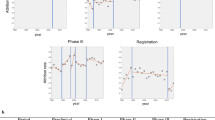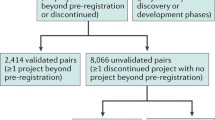Abstract
Transformations and applications of scientific knowledge into new technologies are usually complex interactive processes. Is it possible to detect, from bibliographic information alone, structural alterations and significant events within these processes that may indicate breakthrough discoveries? In this empirical study we focus on R&D processes leading to HIV/AIDS medicines called Integrase Inhibitors. Where scientific progress and discoveries are reflected in research papers, patents signify inventions and technological achievements. Our temporal analysis of distinctive events in this R&D area, tracing trends within both bibliographic information sources, is driven by three bibliometric indicators: (1) contributions of ‘bridging researchers’ who are also inventors, (2) ‘key papers’ that subject experts in the field considered milestones in the research process, and (3) the multidisciplinary impact of those papers. The main results indicate that a combination of key papers, bridging researchers and multidisciplinary impact might help track potential ‘Charge type’ breakthrough developments.







Similar content being viewed by others
Notes
Tracking the citation patterns over a period of 6–24 months after publication, and using this information to predict if a publication exceeds a citation threshold level within 5 years after publication.
Oldest priority data is the date of the earliest filing of a patent application for this invention.
Ciechanover (2009) applies Koshland’s criteria to motivate the classification of the discovery of ‘ubiquitin proteolytic system’ as a ‘Challenge’ rather than a ‘Chance’.
Also known as ‘computer-aided drug design’ or ‘structure-based drug design’.
Lead compounds are, if proven to be an effective drug, the beginning of a group of chemical closely related medicines.
A sixth class is formed by the so called cocktail drugs; combinations of two or more drugs from the other five classes.
Immunology, biochemistry & molecular biology, virology, cell biology, microbiology, infectious diseases, pharmacology and pharmacy, biotechnology and applied microbiology, medicinal chemistry, infectious diseases, and medicine.
The PATSTAT database is the database also known as the EPO Worldwide Patent Statistical Database.
A DOCDB patent family is a collection of closely related equivalent patent publications describing the same invention. 2008 was used as cut-off year because due to procedural regulations more recent patent data were not yet fully available.
This manuscript submission date is however not provided in the databases. For individual publications the submission date of the manuscript can usually be found on the ‘image’ of the publication, but for analysis of larger datasets the use of this date is very laborious and time-consuming, and we therefore had to use the ‘publication date’ provided by the Web of Science. Further research has to be done in this area to estimate the error introduced; Luwel and van Wijk (2012) provides some insights into the nature and extent of this problem.
Although ‘Hazuda 2000’ is seen as an important publication it is just a link in the R&D process that started before this publication, and already produced some patents. The publication of this paper might have been intentionally delayed in order not to infringe with ongoing patent applications. The bibliographic data is insufficient to solve this issue.
CWTS uses 250 distinct subject categories based on the ‘standard’ subject categories used by Thomson-Reuters in the Web of Science database; 60 of these CWTS subject categories are related to medical sciences and life sciences; the themes range from fundamental biomedical research to clinical medicine. It is expected that citations start to come from a increasing and more ‘application’ oriented range of subject categories as research progresses.
References
Ahuja, G., & Lampert, C. M. (2001). Entrepreneurship in the large corporation: A longitudinal study of how established firms create breakthrough inventions. Strategic Management Journal, 22(6–7), 521–543.
Arbesman, S. (2010). Quantifying the ease of scientific discovery. Scientometrics, 86(2), 245–250.
Baba, M., Tanaka, H., De Clercq, E., Pauwels, R., Balzarini, J., Schols, D., et al. (1989). Highly specific-inhibition of human immunodeficiency virus type-1 by a novel 6-substituted acyclouridine derivative. Biochemical and Biophysical Research Communications, 165(3), 1375–1381.
Balconi, M., Breschi, S., & Lissoni, F. (2004). Networks of inventors and the role of academia: An exploration of Italian patent data. Research Policy, 33(1), 127–145.
Bettencourt, L., Kaiser, D., Kaur, J., Castillo-Chávez, C., & Wojick, D. (2008). Population modeling of the emergence and development of scientific fields. Scientometrics, 75(3), 495–518.
Breiner, S., Cuhls, K., & Grupp, H. (1994). Technology foresight using a Delphi approach—a Japanese-German cooperation. R & D management, 24(2), 141–153.
Chandy, R. K., & Tellis, G. J. (2000). The incumbent’s curse? incumbency, size, and radical product innovation. Journal of Marketing, 64(3), 1–17.
Chen, C. (2012). Predictive effects of structural variation on citation counts. Journal of the American Society for Information Science and Technology, 63(3), 431–449.
Chen, C., Chen, Y., Horowitz, M., Hou, H., Liu, Z., & Pellegrino, D. (2009). Towards an explanatory and computational theory of scientific discovery. Journal of Informetrics, 3(3), 191–209.
Ciechanover, A. (2009). Tracing the history of the ubiquitin proteolytic system: The pioneering article. Biochemical and Biophysical Research Communications, 387(1), 1–10.
Cockburn, I., & Henderson, R. (1998). Absorptive capacity. Coauthoring Behavior, and the Organization of Research in Drug Discovery, Journal of Industrial Economics, 46(2), 157–182.
De Clercq, E. (2009). The history of antiretrovirals: key discoveries over the past 25 years. Reviews in Medical Virology, 19(5), 287–299.
De Clercq, E. (2013). Personal communication.
Esté, J. A., & Telenti, A. (2007). HIV entry inhibitors. The Lancet, 370(9581), 81–88.
FDA (2004). Innovation or stagnation? challenge and opportunity on the critical path to new medical products. U.S. Department of Health and Human Services—Food and Drug Administration (FDA).
Furukawa, R., & Goto, A. (2006). Core scientists and innovation in Japanese electronics companies. Scientometrics, 68(2), 227–240.
Grupp, H. (Ed.). (1992). Dynamics of science-based innovation. Berlin: Springer.
Hazuda, D. J., Anthony, N. J., Jolly, R. P., Gomez, S. M., Wai, J. S., Zhuang, L., et al. (2004a). A naphthyridine carboxamide provides evidence for discordant resistance between mechanistically identical inhibitors of HIV-1 integrase. Proceedings of the National Academy of Sciences of the United States of America, 101(31), 11233–11238.
Hazuda, D. J., Felock, P., Witmer, M., Wolfe, A., Stillmock, K., Grobler, J. A., et al. (2000). Inhibitors of strand transfer that prevent integration and inhibit HIV-1 replication in cells. Science, 287(5453), 646–650.
Hazuda, D. J., Young, S. D., Cuare, J. P., Anthony, N. J., Gomez, R. P., Wai, J. S., et al. (2004b). Integrase inhibitors and cellular immunity suppress retroviral replication in rhesus macaques. Science, 305(5683), 528–532.
Henderson, R. M., & Clark, K. B. (1990). Architectural innovation: The reconfiguration of existing product technologies and the failure of established firms. Administrative Science Quarterly, 35(1), 9–30.
Hicks, D. (2000). 360 degree linkage analysis. Research Evaluation, 9(2), 133–143.
Hollingsworth, J. R. (2008). Scientific discoveries: An institutionalist and path-dependent perspective. In C. Hannaway (Ed.), Biomedicine in the twentieth century: Practices, policies, and politics (Vol. 72, pp. 317–353)., Biomedical and Health Research Amsterdam: IOS Press.
IOM. (2009). Conflict of medical research, education, and practice. In B. Lo & M. J. Field (Eds.), Washington, DC: IOM—Institute of Medicine.
Isenson, R. S. (1969). Project hindsight (final report) (Tech. Rep.). Technical Report AD495905, Office of the Director of Defense Research Engineering, Washington, DC, 20301.
Jewkes, J., Sawers, D., & Stillerman, R. (1969). The sources of invention. London: MacMillan.
Julius, M., Berkoff, E. C., Strack, A. E., Krasovec, F., & Bender, A. D. (1977). A very early warning system for the rapid identification and transfer of new technology. Journal of the American Society for Information Science, 28(3), 170–174.
Koshland, D. E. (2007). The Cha–Cha–Cha theory of scientific discovery. Science, 317(5839), 761–762.
Kuhn, T. S. (1962). The structure of scientific revolutions. Chicago: The University of Chicago Press.
Lissoni, F. (2010). Academic inventors as brokers. Research Policy, 39(7), 843–857.
Luwel, M., & van Wijk, E. (2012). Publication delays revisited: 1998–2012. In E. Archambault, Y. Gingras and V. Larivière, (Eds.), Proceedings of the 17th International Conference on Science and Technology Indicators, volume 2, pp. 569–577.
Martin, B. R. (1995). Foresight in science and technology. Technology Analysis and Strategic Management, 7(2), 139–168.
Meyer, M. (2006). Are patenting scientists the better scholars? An exploratory comparison of inventor-authors with their non-inventing peers in nano-science and technology. Research Policy, 35(10), 1646–1662.
Miyasaka, T., Tanaka, H., Baba, M., Hayakawa, H., Walker, R. T., Balzarini, J., et al. (1989). A novel lead for specific anti-hiv-1 agents: 1-[(2-hydroxyethoxy)methyl]-6-(phenylthio)thymine. Journal of Medicinal Chemistry, 32(12), 2507–2509.
Narin, F., & Olivastro, D. (1998). Linkage between patents and papers: An interim EPO/US comparison. Scientometrics, 41, 51–59. doi:10.1007/BF02457966.
Noyons, E. C., Van Raan, A. F., Grupp, H., & Schmoch, U. (1994). Exploring the science and technology interface—inventor author relations in laser medicine research. Research Policy, 23(4), 443–457.
Pauwels, R., Andries, K., Desmyter, J., Schols, D., Kukla, M. J., Breslin, H. J., et al. (1990). Potent and selective inhibition of HIV-1 replication in vitro by a novel series of TIBO derivatives. Nature, 343(6257), 470–474.
Podolny, J. M., & Stuart, T. E. (1995). A role-based ecology of technological change. American Journal of Sociology, 100(5), 1224–1260.
Ponomarev, I., Williams, D., Lawton, B., Cross, D. H., Seger, Y., Schnell, J., and Haak, L. (2012). Breakthrough paper indicator: Early detection and measurement of ground-breaking research. In KG. Jeffery, J. Dvořák, (eds.): E-infrastructures for research and innovation: Linking information systems to improve scientific knowledge production: Proceedings of the 11th International Conference on Current Research Information Systems (June 6–9, 2012, Prague, Czech Republic), pp. 295–304. ISBN 978-80-86742-33-5.
Porter, A., & Rafols, I. (2009). Is science becoming more interdisciplinary? measuring and mapping six research fields over time. Scientometrics, 81, 719–745.
Redner, S. (2005). Citation statistics from 110 years of Physical Review. Physics Today, 58(6), 49.
Roberts, N., Martin, J., Kinchington, D., Broadhurst, A., Craig, J., Duncan, I., et al. (1990). Rational design of peptide-based HIV proteinase inhibitors. Science, 248(4953), 358–361.
Rosenkopf, L., & Nerkar, A. (2001). Beyond local search: Boundary spanning, exploration and impact in the optical disk industry. Strategic Management Journal, 22(4), 287–306.
Small, H., and Klavans, R. (2011). Identifying scientific breakthroughs by combining co-citation analysis and citation context. In E. Noyons, P. Ngulube & J. Leta (Eds.), Proceedings of the 13th International Conference of the International Society for Scientometrics and Informatics (ISSI 2011), pp. 783–793.
Stokes, D. (1997). Pasteur’s quadrant: Basic science and technological innovation. Washington, DC: Brookings Institute Press.
Tijssen, R. J. W. (2002). Science dependence of technologies: evidence from inventions and their inventors. Research Policy, 31(4), 509–526.
Trajtenberg, M. (1990a). Economic analysis of product innovation: The case of CT scanners. Cambridge, MA: Harvard University Press.
Trajtenberg, M. (1990b). A penny for your quotes: patent citations and the value of information. RAND Journal of Economics, 21, 325–342.
Tushman, M. L., & Anderson, P. (1986). Technological discontinuities and organizational environments. Administrative Science Quarterly, 31(3), 439–465.
Van Andel, P. (1994). Anatomy of the unsought finding serendipity: Origin, history, domains, traditions, appearances, patterns and programmability. The British Journal for the Philosophy of Science, 45(2), 631–648.
Wang, R., Gao, Y., & Lai, L. (2000). LigBuilder: A multi-purpose program for structure-based drug design. Journal of Molecular Modeling, 6(7–8), 498–516.
Wang, D., Song, C., & Barabási, A.-L. (2013). Quantifying long-term scientific impact. Science, 342(6154), 127–132.
Wild, C., Greenwell, T., & Matthews, T. (1993). A synthetic peptide from HIV-1 gp41 is a potent inhibitor of virus-mediated cell—cell fusion. AIDS Research and Human Retroviruses, 9(11), 1051–1053.
Zucker, L. G., & Darby, M. R. (1996). Star scientists and institutional transformation: Patterns of invention and innovation in the formation of the biotechnology industry. Proceedings of the National Academy of Sciences of the United States of America, 93(23), 2709–2716.
Acknowledgments
The authors kindly thank Professor Erik de Clercq for commenting on a concept version of this manuscript, Professor Ton van Raan for comments on an earlier versions of this manuscript, and the anonymous reviewers for their valuable comments during peer-review.
Author information
Authors and Affiliations
Corresponding author
Rights and permissions
About this article
Cite this article
Winnink, J.J., Tijssen, R.J.W. R&D dynamics and scientific breakthroughs in HIV/AIDS drugs development: the case of Integrase Inhibitors. Scientometrics 101, 1–16 (2014). https://doi.org/10.1007/s11192-014-1330-7
Received:
Published:
Issue Date:
DOI: https://doi.org/10.1007/s11192-014-1330-7




